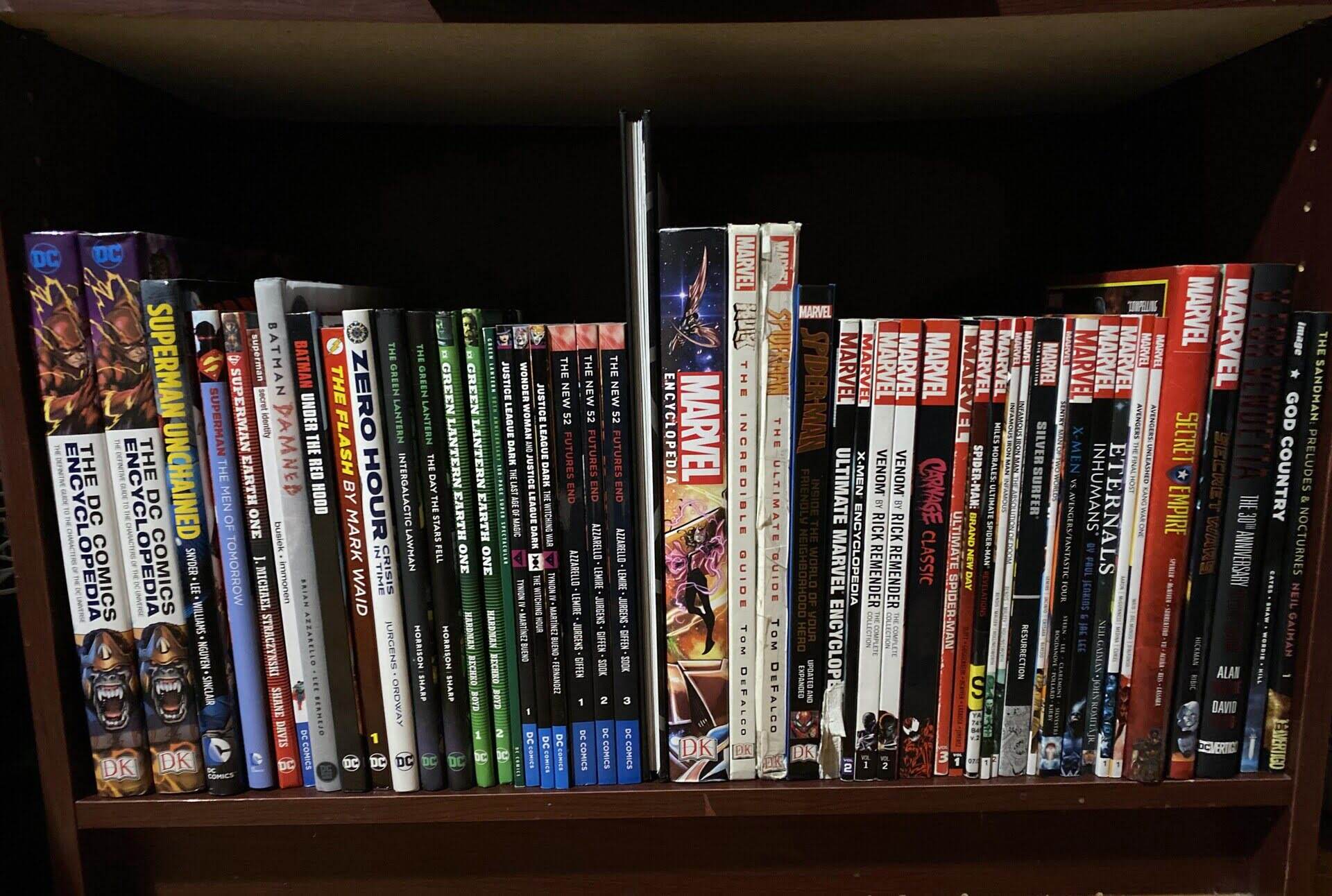

Articles
How To Store Books In Garage
Modified: January 18, 2024
Learn the best techniques for storing articles and books in your garage efficiently and effectively. Maximize space while protecting your precious literary collection.
(Many of the links in this article redirect to a specific reviewed product. Your purchase of these products through affiliate links helps to generate commission for Storables.com, at no extra cost. Learn more)
Introduction
Books are not only a source of knowledge and entertainment, but they can also hold sentimental value. However, as our book collections grow, finding adequate storage space can become a challenge. The garage, with its ample space, may seem like a convenient solution for storing books. However, the garage environment can be quite harsh, with factors such as temperature fluctuations, humidity, and pests posing potential risks to your beloved books.
In this article, we will guide you through the process of storing your books in the garage while taking necessary precautions to ensure their preservation. We’ll cover important steps such as assessing the garage space, decluttering and organizing, cleaning and preparing the storage area, choosing suitable storage options, sorting and categorizing the books, properly packing and labeling them, storing books safely, and maintaining the book storage area.
With a systematic approach and a little extra effort, you can create a functional and safe space for your books in the garage, allowing you to expand your collection without sacrificing valuable living space or worrying about the well-being of your books.
Key Takeaways:
- Safely store books in the garage by assessing space, decluttering, and choosing suitable storage options. Regular maintenance and monitoring help preserve your collection for years to come.
- Protect your books from pests, moisture, and sunlight in the garage. Proper packing, labeling, and organization ensure easy access and longevity for your beloved collection.
Read more: How To Store Books In A Garage
Step 1: Assessing the Garage Space
The first step in storing books in your garage is to assess the available space and determine the suitability for storing your collection. Consider the following factors:
- Climate control: Garages are typically not climate-controlled spaces, which means they are subject to temperature fluctuations and humidity. Extreme heat, cold, or excessive moisture can damage books. Evaluate if your garage experiences extreme temperature changes, leaks, or high humidity. If so, you may want to explore other storage options.
- Light exposure: Natural or artificial light can cause books to fade or deteriorate over time. Assess the amount of light entering your garage and consider ways to minimize exposure, such as installing curtains or blinds or storing books in opaque containers.
- Pest control: Garages are more prone to pests such as mice, rats, insects, and even mold. Ensure that your garage is well-sealed and pest-proofed. If you notice any signs of pests, take necessary precautions to eliminate them before storing your books.
- Space availability: Take a look at the available space in your garage and evaluate how much of it can be allocated for storing books. Consider any existing storage systems, such as shelves or cabinets, and determine if they can accommodate your collection. If not, you may need to invest in additional storage solutions.
By thoroughly assessing your garage space, you can make informed decisions regarding the suitability and potential challenges of storing your books there. If your garage does not meet the necessary criteria for safe book storage, consider alternative options such as spare rooms, basements, or renting a storage unit.
Step 2: Decluttering and Organizing
Before you start storing your books in the garage, it’s essential to declutter and organize your collection. This process will not only help you make better use of the available space but also ensure that you only store books that you genuinely want to keep. Here’s how to approach this step:
- Sort through your books: Start by going through your entire book collection and decide which books you want to keep, donate, or sell. Consider factors such as relevance, sentimental value, and practicality. Be honest with yourself and let go of books that you no longer have interest in or that are in poor condition.
- Donate or sell unwanted books: If you have books that are in good condition but no longer spark joy or serve a purpose, consider donating them to local libraries, schools, or charitable organizations. You can also sell them online or participate in book swapping communities. This way, someone else can enjoy the books, and you create more space for the books you truly love.
- Categorize your books: Once you have decided on the books you want to keep, categorize them based on genre, author, or any other system that makes sense to you. This will help you stay organized and easily find specific books in the future.
- Create a plan: Evaluate the amount of space you have in your garage and estimate how many shelves or storage containers you will need. Plan the layout and design of your book storage area so that you can optimize the available space. Consider leaving some room for future book additions.
- Label your categories: Use labels or tags to mark the different categories of your books. This will make it easier to identify where each book belongs and maintain organization in the long run.
By decluttering and organizing your book collection, you can create a streamlined and efficient system for storing your books in the garage. This step will not only help you make the most of the available space but also ensure that you only keep books that bring you joy and value.
Step 3: Cleaning and Preparing the Storage Area
Before you start placing your books in the garage, it’s crucial to clean and prepare the storage area to ensure a clean and safe environment for your collection. Follow these steps:
- Clear out any existing items: Remove any items that are currently occupying the space where you plan to store your books. This includes tools, equipment, or other miscellaneous items. Clearing out the area will give you a fresh canvas to work with.
- Clean the garage: Sweep or vacuum the floor and remove any dust or debris. Wipe down shelves, cabinets, or any surfaces where you plan to place your books. Clean any windows to maximize natural light penetration into the space.
- Check for leaks or water damage: Inspect the garage for any signs of leaks or water damage. Look for water stains, dampness, or mold growth. If you notice any issues, address them before storing your books to prevent damage to your collection.
- Control pests: Take measures to prevent pests from infesting the storage area. Seal any gaps or cracks where pests may enter. Consider using pest control measures such as traps or repellents to deter rodents or insects. Avoid using harmful chemicals that could potentially harm your books.
- Ensure proper ventilation: Good air circulation is essential for maintaining the condition of your books. If your garage doesn’t have adequate natural ventilation, consider using fans or dehumidifiers to control humidity levels and promote air circulation.
- Consider insulation: Depending on your climate, it might be beneficial to insulate the garage to minimize temperature fluctuations. Insulation can help regulate the temperature and protect your books from extreme heat or cold.
By cleaning and preparing the storage area, you create a clean and suitable environment for your books. Taking the time to address any potential issues such as leaks, pests, or inadequate ventilation can help ensure the longevity of your collection and prevent damage in the long run.
Step 4: Choosing Suitable Storage Options
Now that you have assessed and prepared your garage space, it’s time to consider the various storage options available for your book collection. Choosing the right storage options can significantly impact the safety and organization of your books. Here are some options to consider:
- Bookshelves: Traditional bookshelves are a popular option for storing books. They come in various sizes, styles, and materials. Ensure that the bookshelves are sturdy, well-built, and can withstand the conditions of the garage. Opt for adjustable shelves to accommodate different book sizes.
- Plastic containers: Clear plastic containers with lids can provide protection against dust, pests, and moisture. They are stackable, making efficient use of space. Choose containers that are large enough to fit your books while allowing some breathing room. Label each container for easy identification.
- Storage cabinets: Cabinets with doors can provide additional protection from light exposure and dust. They can also add a touch of aesthetic appeal to your garage space. Look for cabinets with adjustable shelves and lockable doors for added security.
- Storage boxes: Sturdy cardboard or archival-quality storage boxes are another option for organizing and protecting your books. Opt for acid-free boxes to prevent yellowing or damage to the pages. Label each box with its contents for easy retrieval.
- Wall-mounted shelving: If you have limited floor space, consider utilizing wall-mounted shelves. These shelves can be mounted at various heights and can provide a space-saving solution for storing your books. Make sure to securely install them to support the weight of the books.
- Storage racks: If you have a large collection, storage racks with adjustable shelves can be a practical choice. These racks are designed to hold heavy loads and can accommodate a significant number of books. Look for racks made from durable materials such as metal or sturdy plastic.
When choosing storage options, consider factors such as available space, accessibility, durability, and the overall aesthetic appeal. Remember to prioritize the protection and preservation of your books while optimizing the functionality of your garage storage area.
Store books in plastic bins with lids to protect them from moisture and pests in the garage. Keep the bins off the floor on shelves to prevent water damage.
Read more: How To Store Old Books
Step 5: Sorting and Categorizing the Books
Once you have chosen suitable storage options for your books, the next step is sorting and categorizing your collection. This step will help you maintain organization and make it easier to find specific books in the future. Follow these guidelines to effectively sort and categorize your books:
- Decide on a sorting method: Determine the sorting method that works best for you. You can sort books by genre, author, topic, or any other criteria that make sense for your collection. Consider how you will search for books in the future and choose a method that suits your needs.
- Divide your books into categories: Start by separating your books into different categories based on the sorting method you chose. Use separate piles, boxes, or shelves for each category. This will make it easier to organize and locate specific books later on.
- Arrange books within each category: Within each category, consider arranging the books alphabetically by author or title. This will further enhance the organization and facilitate easy access to your books. Use bookends or dividers to keep the books upright and prevent them from shifting.
- Create a catalog or inventory: To keep track of your collection, consider creating a catalog or inventory. This can be a simple list with details such as book titles, authors, genres, and any additional notes. You can use digital tools or traditional pen and paper to maintain the catalog.
- Label shelves or containers: Label each shelf, box, or container with the appropriate category or genre. Clear and prominent labels will help you quickly identify the location of specific books, making the retrieval process smooth and efficient.
- Leave room for growth: As you categorize your books, allow some flexibility and leave empty spaces to accommodate new additions or changes in your collection. This way, you can easily incorporate new books without disrupting your organizational system.
Sorting and categorizing your books is an essential step for maintaining organization and maximizing the usability of your book collection. By implementing a clear and consistent sorting method, you’ll be able to find your books easily and enjoy them to the fullest.
Step 6: Properly Packing and Labeling Books
When storing books in the garage, it’s crucial to properly pack and label them to ensure their protection and ease of identification. Follow these guidelines to pack and label your books effectively:
- Use acid-free materials: Ensure that the packing materials you use are acid-free to prevent any chemical reactions that could damage the books. Acid-free cardboard boxes, archival-quality book sleeves, or acid-free tissue paper can be used to protect your books.
- Wrap fragile or valuable books: If you have rare or delicate books in your collection, individually wrap them in acid-free tissue paper or bubble wrap to provide extra protection against potential damage or wear during storage.
- Stack books horizontally: Store books horizontally rather than vertically to prevent any stressing or warping of the spines. This technique helps maintain the structural integrity of the books and ensures that no book takes unnecessary weight from above.
- Label each box or container: Clearly label each storage box or container with its contents. Include the category, genre, or any relevant information that will help you quickly identify the contents without having to open the box. This will save you time and effort when searching for specific books in the future.
- Avoid overpacking: Do not cram too many books into a single box or container, as this can lead to damage and make it difficult to navigate through the collection. Fill the containers to a reasonable level, leaving some space to prevent excessive pressure on the books.
- Consider using silica gel packets: To control moisture levels and prevent mold or mildew, consider placing silica gel packets in each storage box or container. These packets will help absorb excess moisture and maintain a drier environment for your books.
- Keep valuable books separate: If you have particularly valuable or irreplaceable books, consider keeping them separate in a more controlled storage area within the garage. This can provide an extra layer of protection for these special items.
Packing and labeling your books properly is crucial for their long-term preservation and easy retrieval. By following these steps, you can ensure that your books remain in good condition and that you can easily find the books you want, even after an extended period of storage.
Step 7: Storing Books Safely in the Garage
Storing books in the garage requires some additional precautions to ensure their safety and protection from potential hazards. Follow these guidelines to safely store your books in the garage:
- Elevate the books from the floor: Avoid storing books directly on the garage floor, as it can be susceptible to moisture or potential pests. Consider using pallets, shelves, or storage cabinets to elevate the books off the ground.
- Utilize climate control options: If your garage experiences extreme temperature fluctuations, consider using climate control measures such as dehumidifiers or fans to stabilize the temperature and reduce humidity. This can help prevent damage to your books and preserve their quality.
- Arrange books in an upright position: Store books upright to avoid any bending or warping of the pages. This also helps maintain the integrity of the spines. Use bookends or dividers to keep the books standing and prevent them from leaning or falling.
- Avoid direct exposure to sunlight: Protect your books from direct sunlight, as it can fade the covers and damage the pages over time. Position shelves or storage units away from windows or use curtains or blinds to block the sunlight.
- Check for pests regularly: Regularly inspect your garage for any signs of pests such as mice, rats, or insects. Look for droppings, gnaw marks, or chewed materials. If you notice any signs of infestation, take immediate measures to eliminate pests and safeguard your books.
- Maintain proper ventilation: Ensure proper airflow and ventilation within the garage by opening windows or using fans. Good ventilation helps prevent stagnant air and minimizes the chances of mold or mildew growth on your books.
- Monitor temperature and humidity: Install a thermometer and hygrometer to monitor the temperature and humidity levels in your garage. Aim for a temperature range of 60-75°F (15-24°C) and a humidity level of around 40-50% to provide optimal conditions for your books.
By following these safety guidelines, you can protect your books from potential risks and maintain their condition while they are stored in the garage. Regular monitoring and taking preventive measures are key to ensuring the longevity and quality of your book collection.
Step 8: Maintaining the Book Storage Area
After setting up your book storage area in the garage, it is important to establish a routine for maintaining the space and preserving the condition of your books. Follow these steps to effectively maintain your book storage area:
- Regular cleaning: Dedicate some time to regular cleaning of the storage area. Wipe down shelves, cabinets, or storage containers to remove any dust, dirt, or debris that may accumulate over time. Dusting your books themselves can also help keep them in good condition.
- Monitor for pests: Stay vigilant and look out for any signs of pest activity, such as droppings or chewed materials. If you notice any pests, take immediate action to eliminate them and prevent further infestation. Consider using pest control measures that are safe for your books and their environment.
- Check for moisture and leaks: Regularly inspect your storage area for any signs of moisture or leaks. Address any issues as soon as possible to prevent water damage to your books. Consider using moisture-absorbing products like silica gel packs or dehumidifiers to control humidity levels.
- Rotate books occasionally: To prevent uneven wear on the spines and pages of your books, rotate them periodically. This will help distribute the weight and exposure to light more evenly among your books, ensuring that they age uniformly.
- Keep a record: Maintain an inventory or catalog of your books. Update it regularly, noting any additions or removals from your collection. This will help you keep track of your books and make it easier to locate specific titles in the future.
- Inspect for damage: Occasionally go through your books to check for any signs of damage, such as torn pages, loose bindings, or water stains. Address any issues promptly to prevent further deterioration or spreading of damage to your other books.
- Reorganize when necessary: As your book collection grows or changes, you may need to reorganize your storage area to accommodate new additions or shifting priorities. Take the time to adjust shelves, labels, or categories as needed to ensure optimal organization and accessibility.
By following these maintenance steps, you can ensure that your book storage area remains in good condition and that your books stay well-preserved while stored in the garage. Regular cleaning, monitoring for pests and moisture, and keeping a record of your collection will help you enjoy your books for years to come.
Read more: How To Store Antique Books
Conclusion
Storing books in the garage can be a practical solution for creating additional space in your home while still keeping your beloved collection. However, it is important to take certain precautions to ensure the longevity and preservation of your books in this environment. By following the steps outlined in this guide, you can safely store your books in the garage and enjoy them for years to come.
Assessing the garage space, decluttering and organizing your collection, cleaning and preparing the storage area, choosing suitable storage options, sorting and categorizing your books, properly packing and labeling them, storing books safely, and maintaining the book storage area are all key steps to consider. From evaluating the climate control and lighting conditions of your garage to properly packing your books to protect them from potential hazards, each step contributes to creating an optimal storage environment.
Remember to regularly monitor the storage area for issues like pests, leaks, or excess moisture. Keeping a proper inventory of your books and maintaining a clean and organized storage area will make it easier to find and care for your books over time.
While the garage may not provide the ideal conditions of a climate-controlled indoor space, with careful attention to detail and the implementation of best practices, you can create a safe and suitable storage area for your book collection. Take pride in your library, and continue to share in the joy and knowledge that books bring to your life.
Frequently Asked Questions about How To Store Books In Garage
Was this page helpful?
At Storables.com, we guarantee accurate and reliable information. Our content, validated by Expert Board Contributors, is crafted following stringent Editorial Policies. We're committed to providing you with well-researched, expert-backed insights for all your informational needs.














0 thoughts on “How To Store Books In Garage”